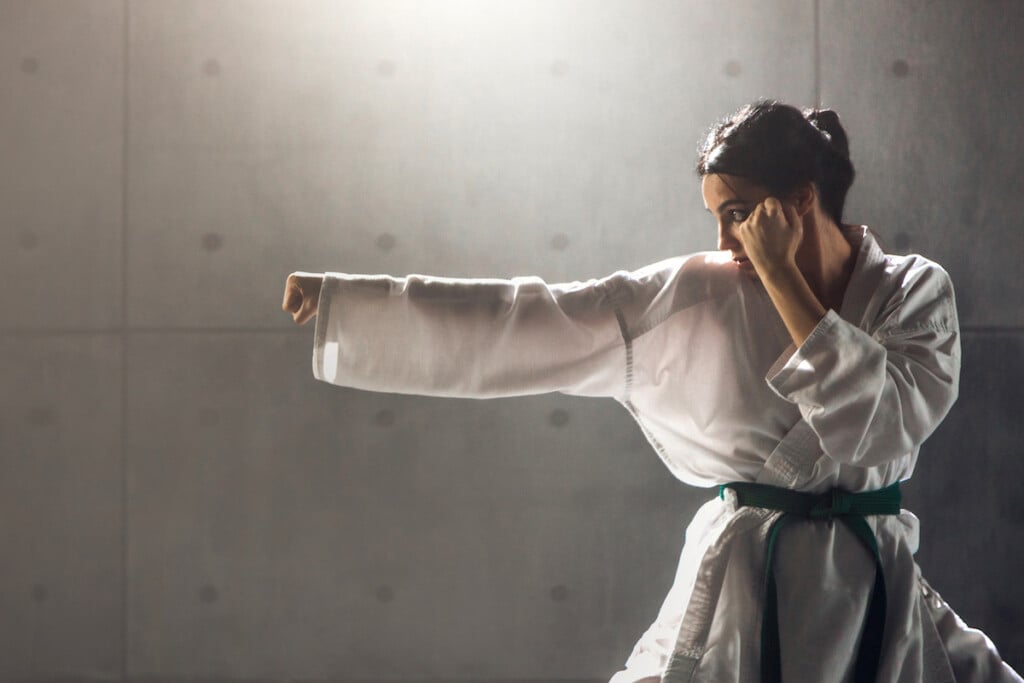Fight To Be Fit
Martial arts training can make you feel like an action hero, but it's also just plain good for your physical and mental health.

Admit it: You’ve watched a fight scene in a movie, be it Jedi crossing lightsabers in Star Wars or the impressive hand-to-hand in John Wick, and thought, “It would be awesome to do that.” The characters look not just cool, but also powerful and in control. It’s an appealing combination—and, with the right training, it’s also an attainable one.
Workouts and fitness routines that incorporate martial arts and combat sports training are becoming more people’s go-to gym activity: karate, jiu-jitsu, kickboxing, even mixed martial arts (MMA). On top of providing a world-class workout that ups your cardio, builds core strength and tones muscles, these disciplines are engaging and fun and can make exercise feel less like a chore. “Any type of martial arts training will build strength and power and improve your balance,” says Mike Duffy, owner of Mike Duffy’s Personal Training in Ocean Township, who has been in the fitness game for 30 years. “It will also help improve your cardiovascular conditioning, flexibility and mobility.”
And the benefits are not just physical. “I have many clients who have a bad day at work or at home, and I can see how wound up they are mentally and how much stress they’re holding when they come in,” Duffy says. “It’s amazing how fast that stress is reduced once they start punching and kicking, either the focus mitts or the heavy bag.” He calls these workouts “confidence boosters,” explaining that people who train in these disciplines often walk a little taller, thanks to both enhanced muscular strength and knowledge of techniques for self-defense. “People are confident knowing that they can protect themselves should they end up in a challenging or dangerous situation,” he explains.
Easy as it is to admit that something sounds intriguing, it’s harder to know where to start approaching it. However, the barrier to entry for this kind of training is not as high as it may seem. Here’s some advice to consider if you are thinking about jumping into martial arts or combat sports, for fitness or for fun:
- Start slowly. Nearly all of these workouts are high-impact and can strain someone who is inexperienced, recovering from an orthopedic injury or surgery, or needs to work around any kind of limitation. Often, higher-level training in something like jiu-jitsu involves sparring, which by its nature includes contact with another person. Because of this, jumping directly into a group class may not be ideal for a beginner, unless that class is explicitly for those just starting out. In a class setting, it can be difficult for an instructor to keep an eye on everyone’s form, and an incorrect form is the easiest way to strain or pull something.
Duffy recommends looking for one-on-one instruction for a little while before transitioning to these group settings. “Most good instructors will be able to tone things down to accommodate beginners, as well as modify exercises for people with physical limitations,” he says. “With a good instructor, anyone can pursue these types of workouts.” He often recommends martial arts training to his senior clients for its positive impact on strength, mobility and balance.
- Think carefully about your discipline. Though they often get grouped together, there are vast differences between different martial arts, ranging from the parts of the body they focus on to the kind of training they encourage. Cardio kickboxing emphasizes fast movement and an elevated heart rate, for example, while karate stresses strikes and blocks and jiu-jitsu puts the focus on grapples and ground fighting. Each of these disciplines also has a deep, detailed philosophy behind it that is often embodied in the kinds of physical movements it demands. Do your research before walking to a gym or a class, and be aware of what that martial art will demand. If you don’t want to be on the ground, jiu-jitsu might not be the best place for you.
“My best advice for a beginner is to go and watch a class,” says Duffy. “See what interests you. Watch what other people do.”
- Stay consciously focused. These workouts are just as much mental exercises as they are physical. They require that a person stay engaged with his or her body and the movements it’s making, rather than zoning into passive movement as people often do on treadmills or elliptical machines, or even on a run. If such spacing out is your favorite part of exercise, this training may not be for you. However, Duffy finds that the mental challenge aspect of a martial-arts workout adds something positive for his clients. “If you are kickboxing or boxing, you must be mentally sharp, because you must remember the punching and kicking combinations. The longer the combinations, the more focused you need to remain. This type of training forces people to concentrate, and it can help improve memory in the long term.”
5 KINDS OF MARTIAL ARTS
Martial arts come not only from all corners of the globe, but also from all periods of history. Here’s a rundown on a few of the more popular ones you may encounter in a gym:
Brazilian Jiu-Jitsu: This discipline focuses on grapples and ground fighting. The goal is the get an opponent on the ground and then put that opponent into a submission hold he or she cannot escape from. It’s high-contact and often taught for self-defense.
Cardio kickboxing: These classes combine punch and kick techniques from other martial arts to create a routine that elevates heart rate and builds strength and stamina. Often, cardio kickboxing focuses on group classes rather than one-on-one sparring.
Karate: Having originated in Okinawa, Japan, karate is an upright martial art that focuses on striking. It aims to use punches, kicks, knees, elbows and open hands to block an opponent’s attacks and then to disable that opponent with a quick strike of one’s own.
Mixed martial arts (MMA): The most modern discipline on this list, MMA is a full-contact sport which, as the name suggests, combines many different techniques from many different martial arts. Punches, kicks and grapples are all allowed in an MMA spar. Often those who practice MMA have backgrounds in other combat sports as well.
Muay Thai kickboxing: While kickboxing is a general term, Muay Thai is a specific discipline within it. Originally from Thailand, it is sometimes referred to as the “art of eight limbs” for the eight “points of contact”—two hands, two feet, two elbows, two knees—that you strike with. These classes usually involve sparring and contact.

